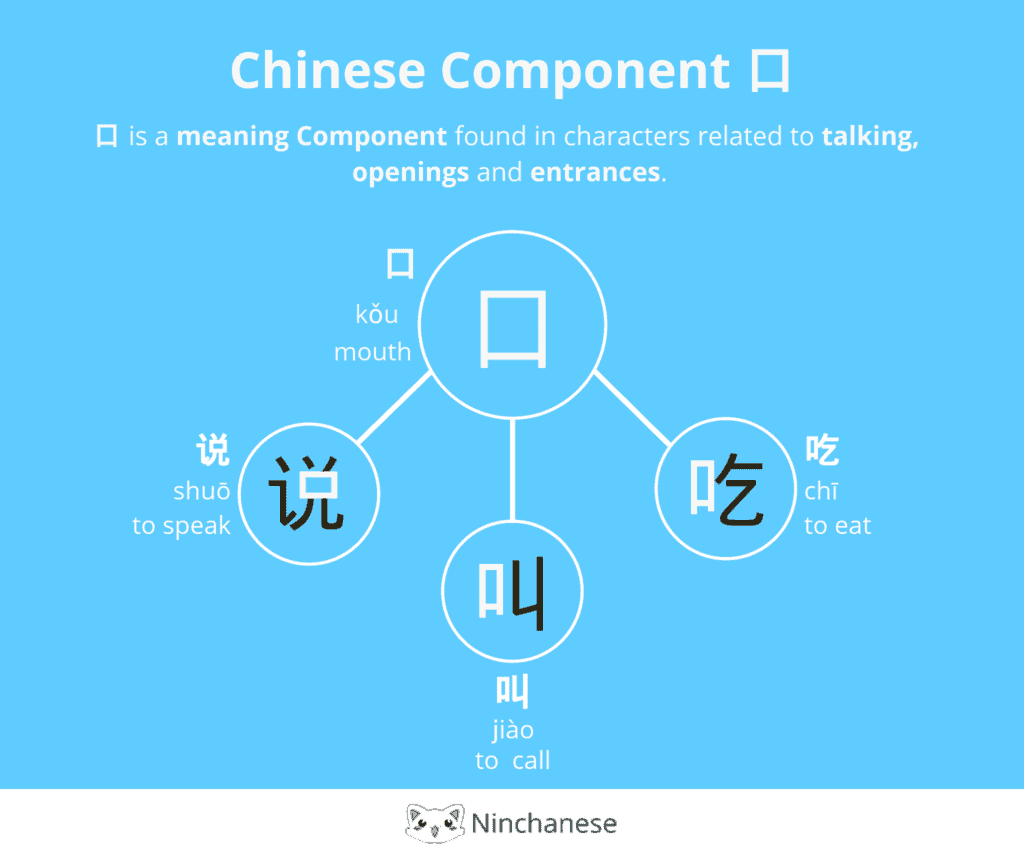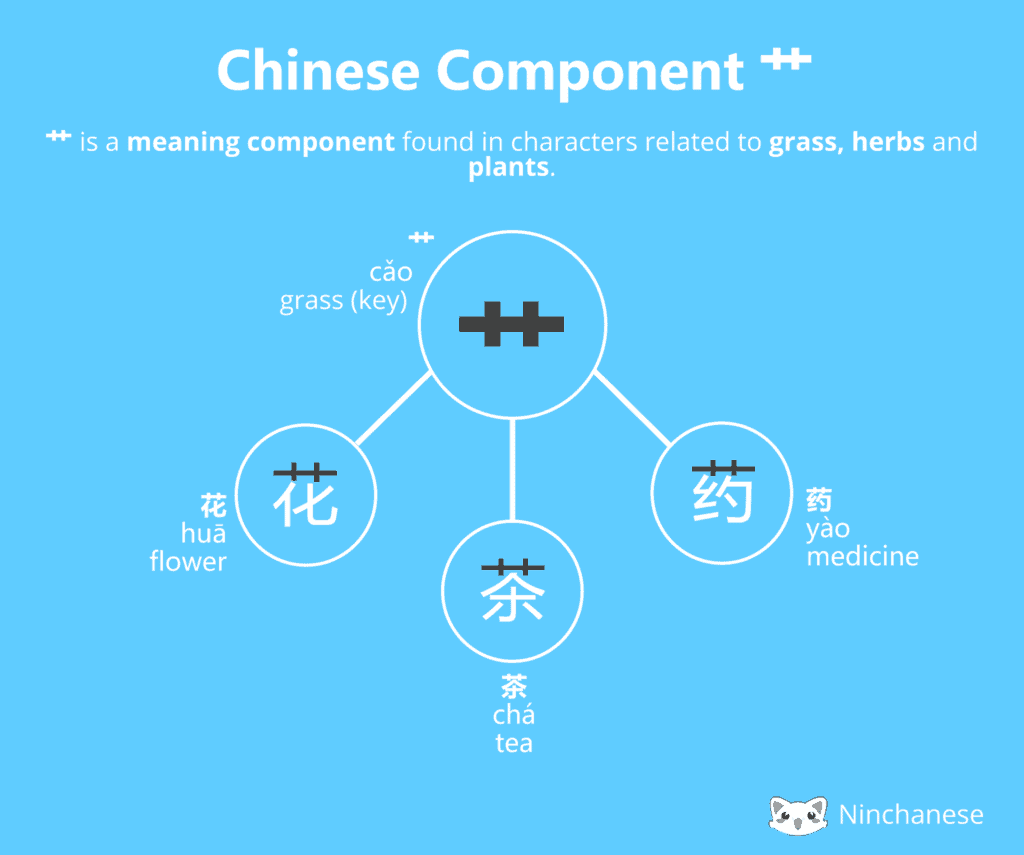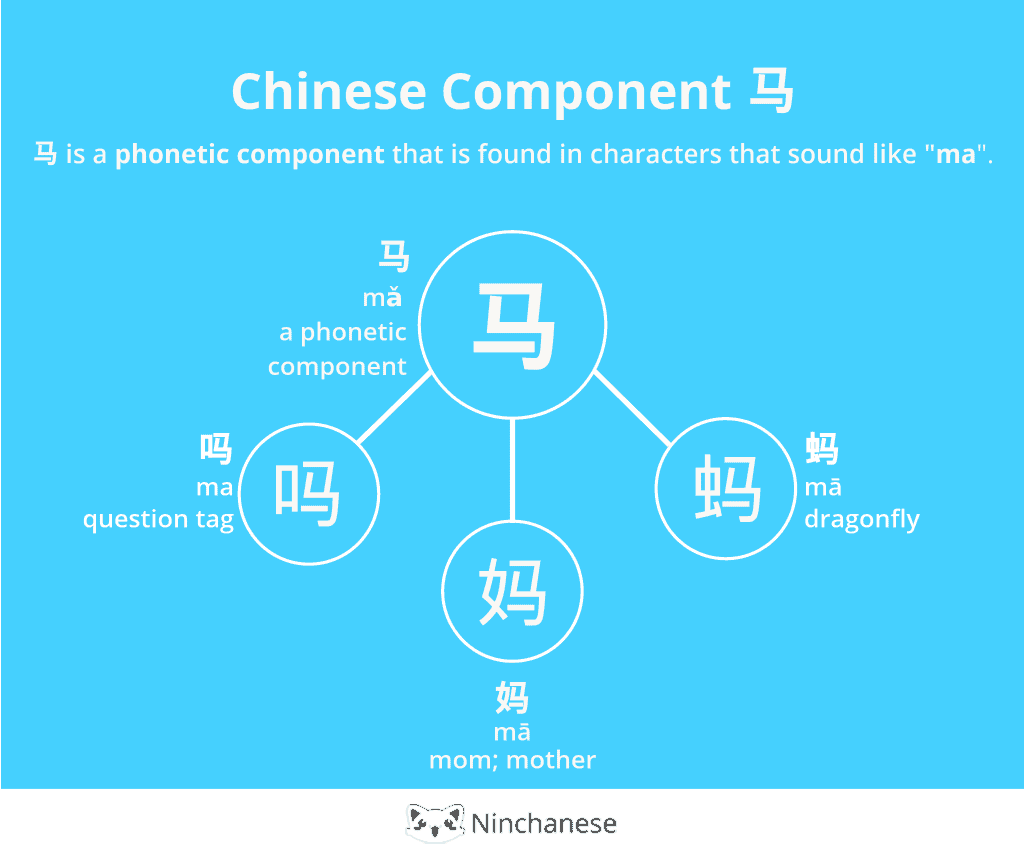Introducing a whole new world on Ninchanese: The Rad Way to Learn Chinese Characters! It’s chock-full of rad Chinese components to discover. What’s so rad about those? Easy: they’re your key to understanding Chinese characters a LOT better. Let’s dive in.
Are you intrigued already? Go right in, the new world’s waiting for you: https://ninchanese.com/chinese-character-components/! Or read on, there are loads more cool things to learn about Chinese components!
The Rad Chinese Component world is a very important step on your way to understanding Chinese characters: in it, you’ll learn the most important Chinese components and radicals to know. There are the building blocks of Chinese characters and this new world will take you up, close and personal with them. That’s a mighty powerful paw to help you advance in your Chinese character comprehension. It’ll unlock many, many doors in your Mandarin Chinese learning.

Harder, Better, Faster, Stronger
By learning Chinese components, you’ll unlock doors like:
- Faster character recognition
- Increased and easier character acquisition
- Greatly improved odds at guessing a character’s pronunciation
- Ability to find out characters’ meanings in a snap
Hang on, what’s a component? What do they have to do with characters?
A Chinese character is actually a set of components combined together. So, by studying the most important Chinese components in the Chinese language and by looking at how they combine, guess what you’re doing? You’re learning Chinese characters!
Once you’re familiar with character components, you’ll be able to break down, recognize, learn, and remember each Chinese character a lot better. So if you seek to understand better the Chinese language, and particularly its written form, this world is for you!
What’s even cooler about them? There are only 200+ components to learn: with these 200+ components, you’ll cover 80% of the 8000+ Chinese characters to know to speak Chinese. Magic.
What’s in this rad new world? 250 essential Chinese components, hand-picked for you.
The RadNew Components turbo reading new world is composed of a careful selection of the very best, most useful, constructive character components you can learn in Chinese.
You can be sure the focus is 100% the Chinese character components that bring you the most value in your Chinese learning. We handpicked all of them and found 250 essential Chinese components for you to learn.
To do so, we compiled a list of the most commonly found components and the world is all about those that are the most useful to learn first in your learning. It was tremendous work to look for them and categorize them all, but we stop at nothing for you, dear little dragons, and we hope you know that!
Excited? Join Lupishu and Nincha in learning these 250 carefully selected character components. You’ll love improving your knowledge of Chinese characters through these quick, bite-sized stages of 10 glorious Chinese components each!
Chinese components also have a secret: There are 3 secret powers they can hold, and use on the characters they’re inside.
Three kinds of components to learn
In the new Rad Component world, you’ll learn three types of Chinese components:
- Meaning
- Phonetic
- Graphic
By learning all three types, you’ll acquire a meowsome foundation in the three major elements of characters: form, meaning, and sound! You’ll know the essential building blocks of Chinese characters, and it’s a very useful skill to have.
Ready? Let’s explore what each type of component is like. First up, meaning components.
Semantic components, aka meaning components.
In addition to being frequent, meaning components are very useful elements in a Chinese character: they will help you determine what the character is going to be about.
Here’s a meowsome meaning component to see how it works:
Chinese meaning component 口
口 kou3, mouth
Mouths are the gateway to lots of things, and the Chinese know that better than anyone else: 600+ characters contain the component 口 and have meanings around the mouth, talking openings, and entrances. Boyah, talk about a gold nugget of knowledge to have!

口 Is found in characters related to mouths, openings, and entrances. Characters like:
- 说 to speak
- 吃 to eat
- 吧 because it’s an oral interjection
See 口’s meaning component page: https://ninchanese.com/chinese-character-components/chinese-character-component-%e5%8f%a3-mouth/
See what we mean? Isn’t it cool to know 口, to spot it in a new character, and to immediately be able to start picturing in your head what the character is going to be about? It’s like you acquired a superpower.
You’ll be learning plenty of super cool meaning characters in the new Component world. One more for the road, we can’t resist showing you how practical it is to know meaning components in Chinese!
Chinese meaning component 艹
Did you know over 500 words contain this component 艹? Talk about a major component to know about. 艹 derives from the character 草 and means grass. As such, because it’s such a cool dude, you’ll find it in characters related to plants, grass, and herbs,
Characters such as:
- 草, grass (艹 is its variant form)
- 花 flower
- 菜 vegetable
- 茶 tea
- 药 medicine, because initially, all drugs were made out of plants.
- 猫 cat, also contains the component grass, because we all know cats dig catnip and grass.

Explore this component in more detail: https://ninchanese.com/chinese-character-components/chinese-radical-%e8%89%b9-grass/
If you see a meaning component in a character, it’ll generally give you an indication of the character’s meaning.
Sound components, aka phonetic components
Phonetic components will often help you to know how to pronounce the character. Since characters evolved, sometimes the pronunciation of the character won’t be quite the same as the components, but it’ll still be very close to the phonetic component’s sound, or perhaps the tones will have changed. Thanks to that, they are often an excellent clue to know.
Here’s the super 马 phonetic component you’ll love knowing:
You’ll find 马 in characters that sound like ma. Easy enough to remember, don’t you think?
Characters like:
- 吗 question word
- 妈 mother
- 蚂 dragonfly

https://ninchanese.com/chinese-character-components/chinese-character-component-%e9%a9%ac-ma/
Let’s explore another great phonetic component.
The phonetic component 中
中, as a character, is pronounced zhōng. The 15+ characters with 中 “zhōng” as their sound component are usually pronounced zhōng, zhòng, zhǒng, chōng, chòng, or chóng. As you can see, they all sound extremely close.
Based on this fact, can you guess how to pronounce 种, 冲 and 钟, or get a close idea of what they sound like?
Yeah?
Bam! You learned how to pronounce:
Just like that!
See? Phonetic components are very handy to guess the pronunciation of a character.
Last but not least, we have:
Visual components, aka Graphic components
Graphic components are components commonly found in characters. They don’t bring a specific meaning or sound. But by learning to recognize them visually in characters, you’ll find yourself spotting them a lot in characters, and that’ll help you remember these characters better and faster.
小, for example, is a graphic component you’ll find in over 20 characters, so you’ll be seeing it around a lot!
Ready to turbocharge your character learning and learn all three types of components? They’re all right here: https://app.ninchanese.com/world/learn-chinese-radicals-components
How effective is it to learn the different types of components? Very!
Very! Here’s a fact you’ll like knowing: about 80% of all Chinese characters are composed of a meaning component and a phonetic component. So, once you learn the most important ones, wham! That 80% are suddenly a lot more within reach.
Let’s look at 蚂 again:
You saw it was pronounced ma, thanks to the presence of the phonetic component ma. Does the other half help you guess what this character is going to mean? Yes! 虫 is a very useful meaning component you find in characters related to insects.
So by studying both halves of 蚂, 虫 and 马, you now know this is probably an insect, pronounced ma. Pretty darn close! 蚂 means dragonfly.
Image
If you change the tone, it can also mean ant – 蚂 mǎ and grasshopper – 蚂 mà
Three new insects to add to your collection in Chinese, and you only learned two components!
Amazing! What else makes components so cool?
Learning Chinese characters is a lot about studying how components combine to form words. Once you’re familiar with character components, you’ll be able to break down, learn, and remember each Chinese character a lot better. Knowing Chinese components will help you in multiple ways:
Visual, meaning and phonetic components give all sorts of clues:
- Visual components allow you to recognize characters much faster
- With Meaning components, understand a character’s meaning at a glance, or guesstimate what this character is about
- Phonetic components are clues to guess how a character is pronounced.
Chinese components boost your reading ability
Thanks to them, you’ll recognize characters at a glance, and since characters are very often composed of one, two, or three components, that’s way easier than breaking them down by strokes. You’ll decipher faster what the characters mean, and get very useful hints to sound them out.
Soon you’ll be able to read and learn Chinese characters that much more easily!
They challenge your conception of characters.
Learning character components also make you take your knowledge further. Exploring one particular component takes you down a super interesting path of how characters evolved and took on new meanings over time. Checking out each component’s page in the dictionary will show you all the characters that contain it, for starters.
How about you look up the component 心 here?
You can also explore these visual explorations of Chinese components. In these pages, you’ll find pages dedicated to some of the main meaning and phonetic components to know. You’ll explore what each component is about, characters it’s found in, and what it does to characters, and these pages are a great visual aid. It’s all right here: https://ninchanese.com/chinese-character-components/
Sounds great, right?
Your super quick shortcut to the key components you need to know to boost your Chinese character knowledge to stratospheric levels is right here: https://app.ninchanese.com/world/learn-chinese-radicals-components.
The Nincha Team
Be Meowsome as always






